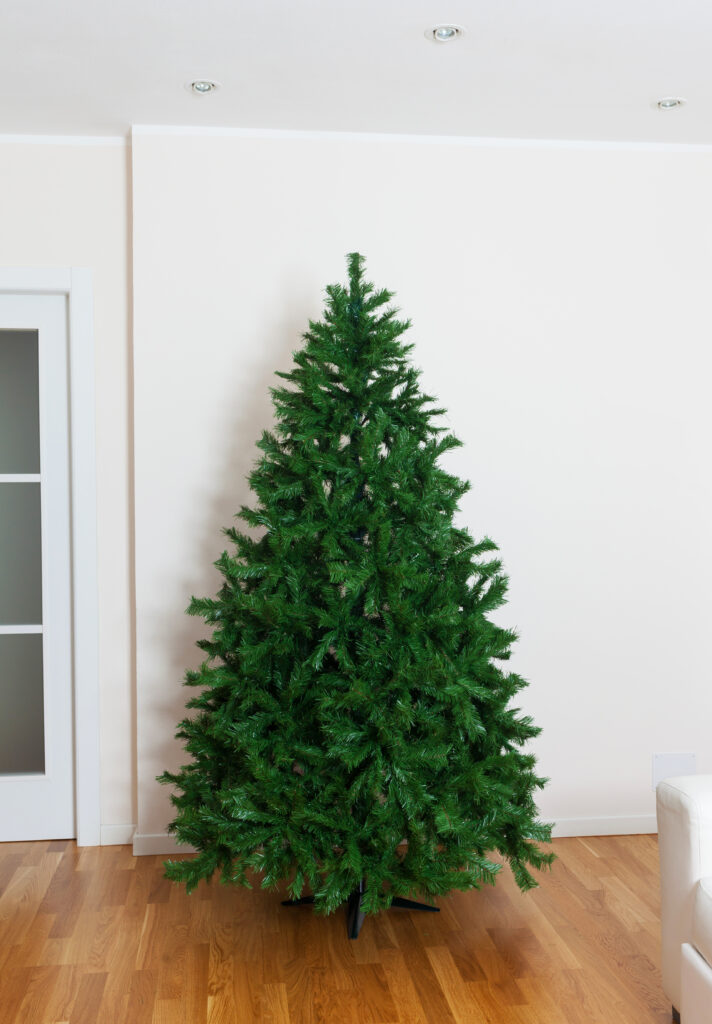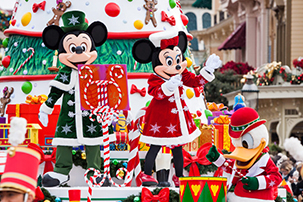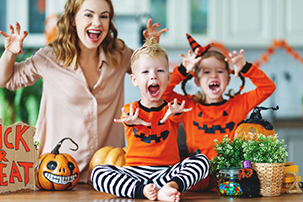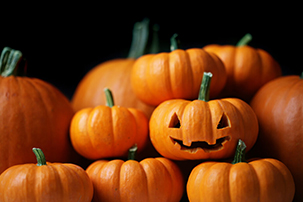

You know you want to buy an artificial tree but where do you begin? You’re probably here because you know there is a lot to consider. Don’t worry, we have broken it down into 5 quick and easy steps to save you some time.
Start here and then check-out the FAQs below. In no time you’ll be well on your way to selecting and purchasing your perfect Christmas tree!
Measure the Size of Your Space
Before you can select an artificial tree you must consider the size of your space.
- Where will you display your tree each year? Measure the height and width of this space.
- Plan to leave at least 9 inches to one foot between the top of the tree and ceiling. This should include your stand and take into account your tree topper of any sort as well. You don’t want anything touching the ceiling.
- A good rule of thumb is to choose a tree 2 feet shorter than your ceiling height. For example, a room with 8 foot ceilings could handle a 6 foot tree and a room with 9 foot ceilings could handle a 7 foot tree etc.
- Where will you store your tree each year? How will you store the tree each year? Will it remain assembled or in storage bags?
- How will you move the tree to storage? (A larger tree will be heavier, but you can disassemble it and store it in separate pieces to make moving easier).
You need to be sure you will have enough space for both display and storage.
Determine the Best Profile
Step two involves deciding on a tree profile which involves width, just as in step one above. There are several options, but again be sure to consider your space. Also check the manufacturer’s website as the measurements provided here are averages-just a guideline- to get you started on the decision making process.
Pencil
The narrowest tree option. Think tall and skinny! Measuring across the widest part of the base, the average pencil tree is 24 inches or less. Perfect for spaces where you want height, but not width. Ideal for apartments or a secondary tree in spaces like entryways, bedrooms, kitchens, game rooms, kids rooms, etc. Generally light and easy to carry.
Narrow/Slim
A good middle of the road option between pencil and full. These average about 43 inches across the widest part of the tree (diameter) on a 7 foot tree. This is ideal for apartments or homes with less space. If space is not an issue these make ideal secondary trees. This size works well in family rooms, kitchens, bedrooms, entryways etc. anywhere where you want extra holiday cheer!
Medium
This is a good size tree for a traditional look in a smaller space. This tree has the traditional cone shape with less width at the bottom, between 45 and 50 inches across the base on average. This is perfect for those who want a traditional shape and look with a slightly smaller base.
Full
This is what most people picture as a traditional cone shaped Christmas tree. The average size is about 50 inches (or more) across the base (diameter) for a 7 foot tree. Lots of width near the bottom and lots of room for ornaments and decorations.
Wall/Flatback
These trees are essentially a half tree for smaller spaces. Imagine if you cut a tree in half vertically-seriously-that is this tree. This tree is meant to stand next to or hang from the wall. If you have a small space, but want a traditional look (height and width) this could be the tree for you. A true spacesaver!
Consider Tree Style
As you are narrowing down your selection, also consider the style for the tree. This will help narrow your search when you move to the final step.
Upside down trees
Are you interested in having your tree hang upside down from the ceiling? If so, there are trees that do this! (I was shocked the first time I saw one!) Be sure to consider height and weight here as this will take some special installation to anchor to the ceiling. This is not renter friendly!
Traditional
A traditional tree is a traditional variety in classic natural green.
Flocked
Flocked trees look like they are covered in snow and fresh from an idyllic forest. These look natural and rustic. Easy to work into any holiday décor theme.
Tinsel
Tinsel trees offer a variety of fun colors to choose from including silver, champagne, pink, black, white, orange, gold, ombre, etc. These are fun, festive, cannot be missed additions to any décor!
Fiber Optic
If you’re looking to add some fun to your space a fiber optic tree is a low maintenance way to do so. Fiber optic light fibers are incorporated within the branches to give the tree the look of glowing from within. Most come with a color wheel so you can select which colors the fibers will display and when. Unexpected and festive!
Pre-lit or Unlit
You’re getting closer! You have an idea now for the height, profile, and style of your ideal tree. Now it’s time to consider lights. Do you want it to be pre-lit or unlit? If you don’t immediately know your answer, check out How to Decide Between a Pre-lit or Unlit Artificial Christmas Tree and then come back to this page.
Start Shopping!
As you begin shopping, consider the following.
- Number of tips at the end of branches. The more tips the more full the tree will appear.
- Number of lights for prelit trees. Most prelit options are moderately lit with about 100-150 lights per vertical foot of height. If you want more or less be sure to look for light counts in the product listing.
- Company information and online reviews. Read reviews for the specific tree you want to buy as well as the company selling the tree. This will give you insight on customer service, durability, ease of assembly, etc.
- A warranty is provided for most new artificial trees. The average warranty is 2-3 years with some as high as 10 years. Read the warranty so you know what is covered.
You may still have a few lingering questions about which tree is the perfect fit. Check out our frequently asked questions below for some clarity.
Artificial Christmas Tree FAQs
How long do artificial trees last?
Artificial trees are generally designed to last about 10 years. However, each brand and specific tree variety will be different. Check the manufacturer’s website. Many artificial trees come with a warranty too. Most are for 2-3 years and others can be as high as 10 years.
Do prelit LED trees last longer?
Yes, they can last longer. In general LED lights are more energy efficient and longer lasting than regular incandescent lights. According to the U.S. Department of Energy, LED lights can last 25% longer than incandescent lights. If you’re looking for a prelit tree to keep for 10+ years, make sure to look for one with LED lights.
Which is better: a prelit or unlit artificial tree?
This will depend on several factors that are unique to you! Check out this article for an easy to use decision making chart, How to Decide Between a Pre-lit or Unlit Artificial Christmas Tree.
How much should I spend on an artificial Christmas tree?
The good news is there are artificial trees for almost every price point. It will all depend on your budget and what you want to spend. Small trees can start at $50 and larger trees go all the way up into the $1,000 dollar range. Most trees from big box, home improvement and craft retailers average between $150 and $500.
Prices will vary for special features as well. Things like flocking, LED lights, pre-decorated branches, fiber optics, and special colors of trees.
When is the best time to buy an artificial Christmas tree?
Artificial trees are available year round online, but there are several key times during the year to keep an eye out for discounted artificial trees.
- Black Friday
- Cyber Monday
- Week before Christmas
- Week after Christmas
- July-many retailers run sales
Amazon Prime Day
Target Deal Days
WalMart Deals for Days - October
- When trees are first hitting the retail shelves you may find a deal.
- Hobby Lobby and Michaels-both retailers run a few 50% off tree events during the fall months. Check their websites for the weekly ads!
Is it ok to store my Christmas tree in the garage?
This will depend on the temperature and wetness factors in your garage (leaks or humidity etc.). A good general rule of thumb is to choose a location that remains between 40 and 90 degrees Fahrenheit year round.
Water and heat are the two main enemies of artificial trees because they can cause melting, fading, yellowing, mold and mildew. (You do not want water anywhere near the electrical components of a pre-lit tree.) For complete details on the best way to store your tree check out Everything You Need to Know About Artificial Christmas Tree Storage.
Will I need to clean an artificial tree?
Possibly, it depends on how you store it. If you take care of it during the off season, It is unlikely that you will need to clean it very often. Cleaning an artificial tree isn’t as difficult as it sounds. For step-by-step instructions see How to Clean Every Type of Artificial Christmas Tree.
Why are artificial trees so expensive?
Artificial trees are more expensive than real trees because they are made to last for about 10 years. If you opt to purchase an artificial tree, the cost the first year will be higher than if you buy a real tree. The average cost for a real tree in the United States in 2020 was about $81, according to the National Christmas Tree Association.
However, over time you will actually end up spending less. For example, let’s say you plan to spend $400 on an artificial tree. That’s about 5 years worth of real trees at the average rate of $81. Bonus-your artificial tree is built to last 10 years, so that’s another five years of use at no additional cost!
What is a PE artificial Christmas tree?
PE stands for polyethylene which is known to be a safer type of plastic than PVC (polyvinyl chloride). PVC is known for containing dangerous chemicals including lead. If you are in the market for a non-toxic tree, look for PE, PP (polypropylene) or PVC-free on the manufacturer’s website or packaging.
How many lights do you need for an unlit Christmas tree?
A good general rule to follow is one strand of lights per vertical foot of tree height. For example, a 7 foot tree would need 7 stands of lights. You can always use more or less, but this is an average amount for a traditional look. For complete details see-Find the Perfect Number of Lights for Any Christmas Tree.
How many ornaments do you need for a 6 foot tree?
This will vary depending on the size of the ornaments and the profile/width of your tree. A good rule of thumb is 10 ornaments per vertical foot for all trees under 9 feet tall. So a 6 foot tree would need about 60 ornaments. If your tree is a slim variety you may want to use a few less. (Trees over 9 feet can generally handle anywhere from 15-20 ornaments per vertical foot!).
It is visually pleasing to the eye to see objects of different sizes, so it is a good idea to have a mixture of small, medium and large ornaments.
Check out How to Find the Perfect Number of Ornaments for Your Christmas Tree
Are flocked trees safe for pets?
Yes and no. FLocking can be toxic to pets according to PETMD. It can also depend on if the flocking is made from toxic or non-toxic ingredients and how much is ingested by the pet. A little bit of either will likely not be life threatening.However, if you have curious pets who like to chew, a flocked tree may not be the best option.






